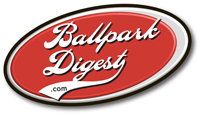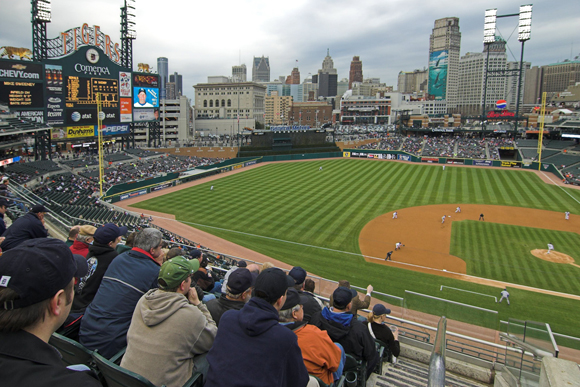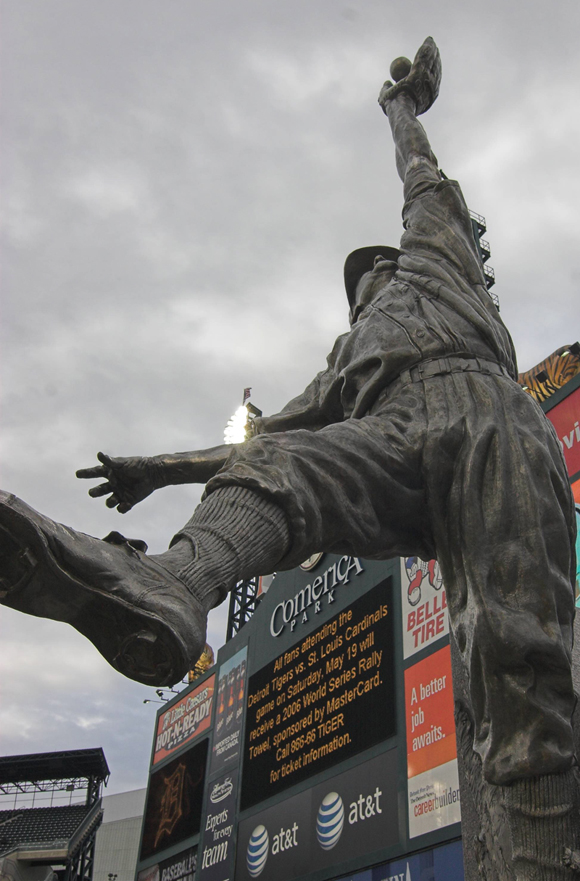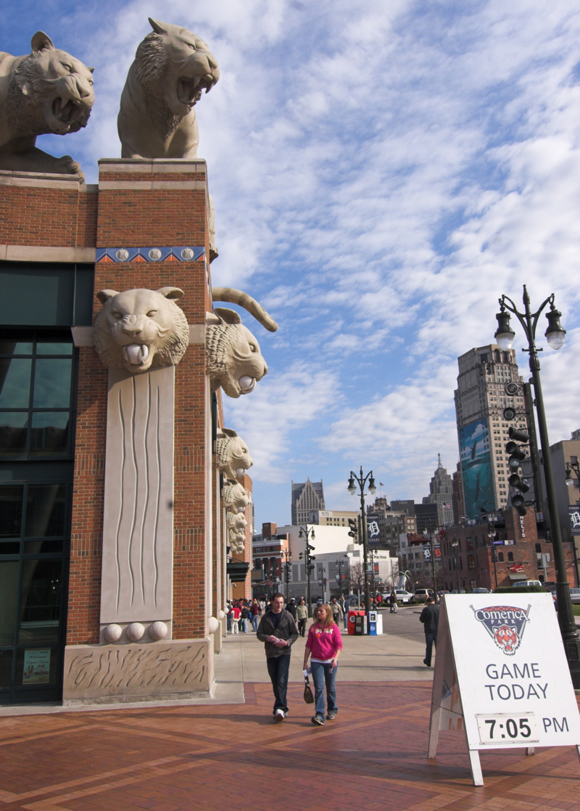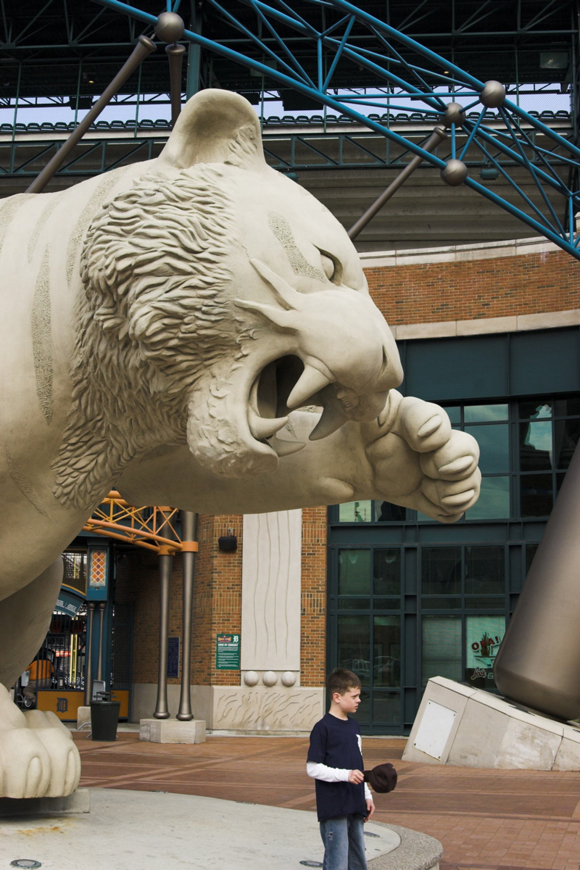Comerica Park is never going to be as beloved or as celebrated as Tiger Stadium. It is a ballpark Donald Trump might like because there seems to be an endless font of ways for people to spend money. Owner Mike Ilitch looked at his club’s past and decided it had merit as a first course to the main meal. Traditionalists may not like the place but c’est la vie. The Tigers have learned that you can’t win the pennant every year but you can always find a new revenue source. As long as the person buying it is happy, what’s the problem?

FAST FACTS
Capacity: 40,950
Owner: Detroit-Wayne County Stadium Authority
Architects: Populous (General), Rockwell Design Group (Themed Architecture) Construction: Hunt-Turner-White
Dimensions: 345L, 370LC, 425C, 365RC, 330R
Original Cost: $300 million
Playing Surface: Grass
Website: mlb.com
Phone: 313/962-4000
League: American League
Parking: Lots near the ballpark charge between $5 and $20
Address/Directions: 2100 Woodward Av., Detroit, MI 48201. The ballpark is located in downtown Detroit, so basically if you head downtown via M-10 or I-375 you’ll hit the ballpark.
Written by: Dave Wright
Photos by: Jim Robins
Succeeding a local legend is never easy. In 1992, Bob Rathbun and Rick Rizzs were announced as the new radio broadcasting tandem for the Detroit Tigers. Both were fine announcers with long pedigrees. Unfortunately, they were replacing the beloved Ernie Harwell, the Hall of Fame voice who had been behind the mike for decades as the Voice of the Tigers. (Harwell had been fired as part of a series of foolish moves instigated by then-team president Bo Schembechler.)
From the start, the pair was roasted in the press and in the public. Although they lasted three years together, the joy in town was immense when Harwell returned in 1995. (Rathbun now calls games for Atlanta of the NBA and Rizzs is one of the voices of the Mariners.)
It’s an instructive way to introduce the current Tigers’ home park. Judged on its own merits, Comerica Park, which opened for business in 2000, is a perfectly fine facility.
Yet, in the minds of many Detroiters, it suffers from the simple fact that it is not Tiger Stadium, where the club held court for 87 seasons.
In many ways, Comerica could be considered the anti-Tiger Stadium. It is as if team owner Mike Ilitch, who coughed up 62 percent of the ballpark’s $300-million price tag, gave the architects this instruction: Go to Tiger Stadium and take notes. If I see one thing that looks like the old park, you’re fired.
Traditionalists may decry this but the fact remains that a lot of what occurs at and around Comerica is a significant improvement over the old place.
Parking can be a bit of a problem. Most lots near the park went for $15-20. This is, remember, downtown Detroit so it is advised to have a pre-game plan where to park, how to get there and how to get out. But things have gone smoothly the two times I visited.
Whereas Tiger Stadium’s direct neighborhood offered little of interest (and a lot to worry about), Comerica is located in the vibrant theater district in downtown Detroit. While it is seriously advised to know where you’re going, there is a lot happening around the ballparks. Several excellent bars and restaurants are within a block or two of the park. (Hockeytown Café, across the street from Comerica, is the best known of these places. Its reputation is well earned but can be hard to get into on gameday. Looking for a smaller place to have a cold beer and a good burger/hot dog at a lesser price? Pop into the Elwood Grill, located behind the right-field fence near Ford Field.)
From the time you get near the gates of the park, you are quickly aware Ilitch wanted it to be more than just a ballpark with nooks and crannies.
Outside the park is a giant Tiger statue and a smaller one of Harwell, the peppery 81-year old who still pops in occasionally to call an inning or two of a game and writes a column for a local newspaper. Inside are non-traditional baseball entities such as a Ferris Wheel and a Carousel. There are times where one isn’t sure if he is visiting a ballpark or the Michigan State Fair.
Interested in eating and drinking? There are concession stands everywhere. Some deals are better than others (The pepperoni pizza — Little Caesar’s, naturally — is a pretty good deal at $2.75. You can take your pick of other edibles at a large food court. Frisch’s Big Boy, a well-known Midwest restaurant chain, offers its trademark double burger for $5.50. They even offer a Kosher Hot Dog that is quite tasty.)
I couldn’t keep track of how many different beers were available. Some are fairly expensive (a large Labatt’s goes for $8.50) but smaller tap beers were available for five bucks. Care to go a little harder? Have a daiquiri. Fancy a good smoke? Head to the Cigar Bar above Section 113.
Missed last night’s game? Pick up a free Detroit News. Want to take home a unique souvenir? The team actually has a jewelry table (and a catalog) that offered everything from pendants to an expensive copy ($3,700) of the ring given to the 2006 AL champs. There are a lot of souvenir stands. There are five separate merchandise outlets inside the ballpark, as it seemed like every player who ever wore the old English D had a signed baseball for sale.
In a betting mood? There are lottery machines that offer payoffs as high as $100,000.
All this diversion from the game on the field is somewhat understandable when you remember that, before the remarkable turnaround that led to winning the 2006 AL flag, the Tigers had 12 consecutive seasons under .500. In their last year at their old home, they finished 27½ games out of first place. In 2003, they barely avoided history as the worst team in modern history by winning three of their last four games to finish 43-119, a game better than the 1962 New York Mets.
Perhaps as a salve to relieve the pain of watching the team on the field in the first few years of Comerica, the Tigers went whole hog reliving their past. Walk underneath the stands and you’ll find several displays with stories of the team’s 100-plus year history, noting the good years and bad. Even in their bad times, Detroit had a series of colorful players, ranging from Ron LeFlore, who was paroled from prison to play for Detroit (and eventually led the league in stolen bases) to Mark Fidrych, who talked to the baseball en route to winning 19 games as a rookie for a 69-92 team in 1976.
Twenty years at a time, the Decades Monuments pay tribute to Tigers’ achievements along the main concourse. Kirk Gibson famously celebrates his eighth-inning Game Five 1984 World Series homer off of the Padres’ Goose Gossage.
Since there is so much to see and do before you go to your seat, one was ready for the worst when entering the actual stands. Surprisingly, the inside of the place isn’t that bad. True, the ticket prices are a little higher than some teams ($60-65 around home plate) but I found a perfectly acceptable seat six rows from the field for $30 down the right field line. The center- and right-field bleachers (where the team has sold several season tickets) is a decent deal at $10. (Left field, which is up a little higher and under the main scoreboard, runs $15)
There is, however, one notable difference from its predecessor. Tiger Stadium was known for its lower deck angling close to the field. Or at least it seemed that way. If you land in the second level of the lower deck at Comerica, you are far away from the action. The good news is most of this seating area have a small table area between the seats to place drinks, programs, etc. The upper deck runs several rows but is not as high in the sky as some parks like, say, U.S. Cellular in Chicago.
There is stuff to see inside the park as well. Several statues and plaques honoring former Tiger greats abound everywhere. There are two huge cars sitting on the batter’s eye in center field. The city’s skyline looks nice behind the outfield wall. There are a few between-innings promotions and a new, nifty video board in right field to track out-of-town scores and game information.
Tiger Stadium’s main claim to fame was its reputation as a home-run park along with some quirky dimensions. There is no overhang in right field here and the flagpole isn’t in play. The team moved fences in a few years ago – and longball totals have dramatically increased. (This gives you more chances to see one of the park’s most enjoyable features – a huge Tiger whose eyes begin to glow when the home team hits a home run. One wonders if the eyes burned out last October when Magglio Ordonez hit the ninth-inning shot that sent the team to the World Series.)
For years, the Tigers’ marketing techniques were as poor as their on-field play. They have stepped that up regard considerably and it shows. The vendors visited the box seats often. Ushers did a solid job of controlling traffic but allowed youngsters a chance to get close to the field prior to game time. There are a few interesting between-innings diversions and plenty of good customer service.
Comerica Park is never going to be as beloved or as celebrated as Tiger Stadium. It is a ballpark Donald Trump might like because there seems to be an endless font of ways for people to spend money. Ilitch looked at his club’s past and decided it had merit as a first course to the main meal. Traditionalists may not like the place but c’est la vie. The Tigers have learned that you can’t win the pennant every year but you can always find a new revenue source. As long as the person buying it is happy, what’s the problem?
